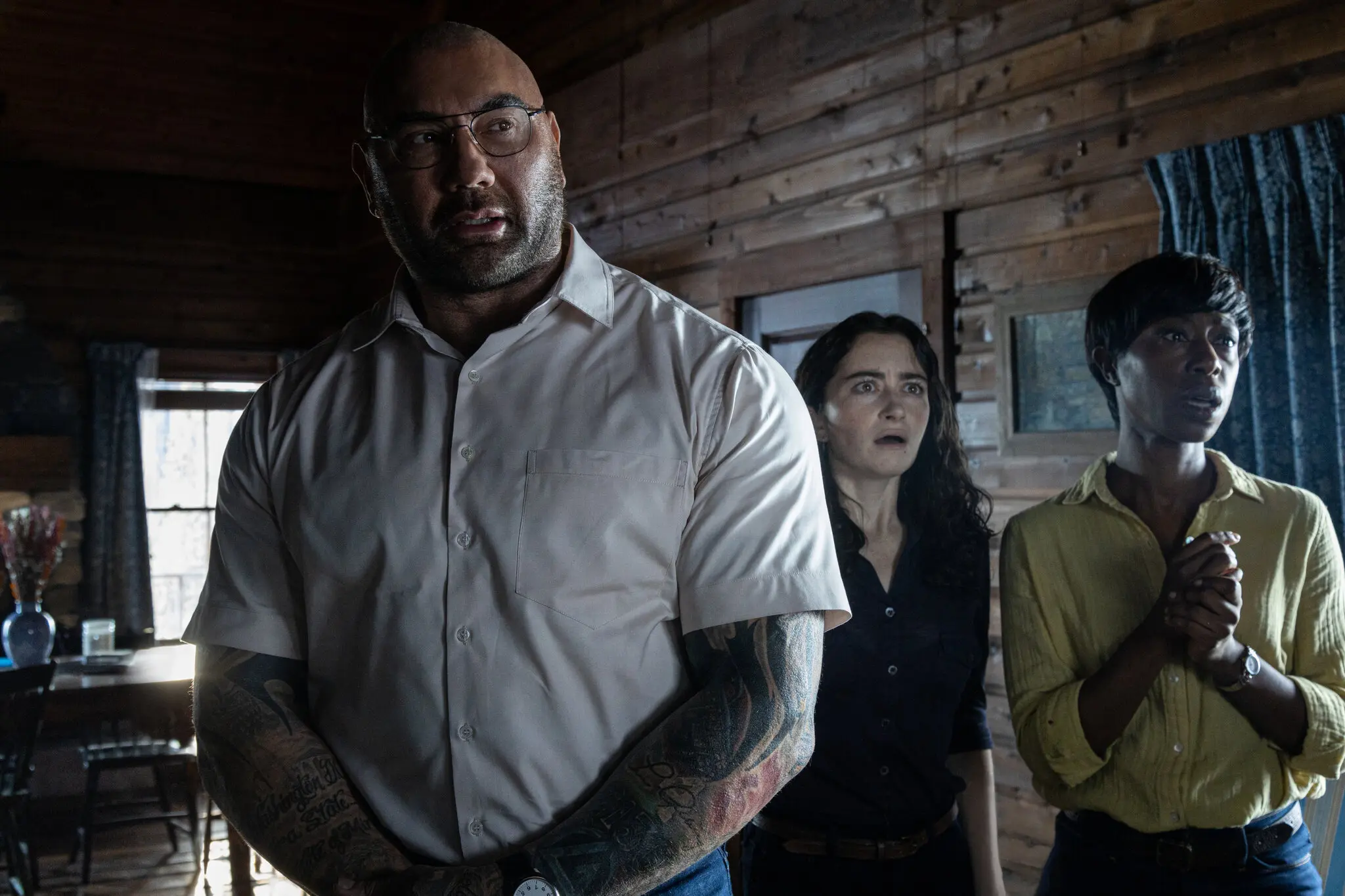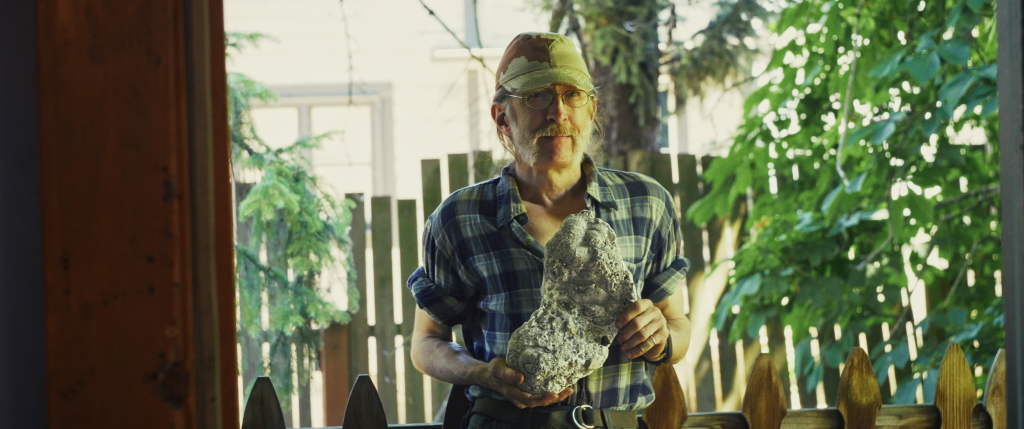Reviews
‘Knock At The Cabin’ (2023) Review

Are you there God? It’s me, Dave Bautista.
A New Movie From Director M. Night Shyamalan
M. Night Shyamalan’s movies make me feel weird. Not weird in the sense that they astound me or are bafflingly strange or terrifically bad, simply that they don’t seem to hit me with their divisiveness.
Since I was a young filmgoer on Al Gore’s internet, I have heard every joke about M. Night Shyamalan’s career. We all know the man has an exaggerated reputation. Once Hollywood’s darling, now its greatest punching bag, I genuinely feel apprehensive about covering his work because of the unnecessary aggression many people have towards him and his filmmaking, both in defense and in attacking his oeuvre. There’s a need among critics at this point to mythologize Shyamalan’s work in a way that is, honestly, just kind of annoying.
The Emotional Disconnect of Shyamalan’s Horror Films
Because I sometimes feel mentally broken looking at them. Especially with his horror films, and especially waiting for my hatred or love of them to sink in. And neither happens. They’re just fine. Even The Happening, reviled as one of the best “so-bad-its-good” horror movies, is sort of just a void to me. I’ve seen it twice, and it doesn’t do much either way.
They’re okay. Devil was fine. The Visit was fine. Split was fine. Everything he does to me, is just fine.
All of this very long preamble is to say my voice as a critic tells me Knock at the Cabin is much of the same, and if you have strong inclinations about Shyamalan’s filmmaking like many do, this film is a pendulum that will swing in your direction.
A Cast of Heavy Hitters Led by Dave Bautista
For the uninformed, Knock at the Cabin is based on the acclaimed Paul Tremblay novel The Cabin at the End of the World. It follows couple Eric (Jonathan Groff) and Andrew (Ben Aldridge) who, while on vacation with adopted daughter Wen (Kristen Cui), find themselves besieged by a doomsday cult that holds them captive. Led by the awkward giant of a man, Leonard (Dave Bautista), and united by visions of the apocalypse that force them to choose which among them will be sacrificed to stop the world’s end.
This cast, rightfully, piqued a good deal of people’s interests. Many have been curious to see Bautista take on more serious roles, and for those excited about that prospect, you will enjoy yourself. He wonderfully inhabits the character of Leonard, a violently neurodivergent doomsayer burdened by a task he believes wholeheartedly. The role is meaty enough for him to work with but not so distracting that he detracts from anyone else in the cast. His companions, played by Nikki Amuka-Bird, Rupert Grint, and Abby Quinn, are also good, barring some awkward line deliveries, but we’ll get back to them soon.
Strong Chemistry, Underutilized Characters
As for Eric and Andrew, Groff and Aldridge have undeniable onscreen chemistry, making a very believable pair; Aldridge is the calloused human rights attorney, while Groff is his much more softhearted husband, and the two balance each other nicely. But for some reason, the two are not particularly compelling in their struggle until their final scene together, which itself is marred by some ham-fisted dialogue despite being ultimately touching. I think it’s because the movie doesn’t give them much to do until the final act, with most of their speaking lines coming from flashbacks to difficult times in Eric and Andrew’s relationship. As a result, much of the onus to entertain and astound is on Bautista’s suicide cult.
The Cult’s Dynamic: A Missed Opportunity
And that’s another hiccup. One of the conceits of how the cult operates hurts what I like the most about the supporting cast; their nervous energy works well off one another, with all the actors’ dread bouncing off electrically as they trade lines. But it doesn’t last that long because…
They begin killing each other to initiate the very real plagues that will destroy everything. Which is an interesting idea, but in practice deprives us of a lot of great character interactions that I’m assuming were in the book and condensed down to a sub-2-hour runtime. While those developments on the ground shaking and the sky falling can be scary, it seems to ignore the human interactions we’re here for.
A Serviceable Script with Thematic Depth
The script is tight, and serviceable for the most part, except for some strange line choices. Thematically the movie isn’t overly ponderous or paper thin, it communicates its thoughts on the thin line that can sometimes appear between faith and delusion quite well, and the weight of the sacrifice is never diminished. The choice to utilize flashback segments wasn’t one I can outright call bad, but they don’t add enough of an emotional punch, or at least don’t add anything that wasn’t already present. The script is fine.
An original score that can ratchet up some of the tension in a film where it’s not always present is an aspect of the film I can appreciate. As far as technical praise goes, the lighting works in tandem with the set design nicely. On the other hand, there’s somewhat obnoxious camerawork that emphasizes a lot of very dire close-ups of characters. The movie opens with one of these, and it’s a few minutes long, shot reverse shot of two faces right next to each other. I understand what they’re trying to communicate, Leonard encroaching on Wen’s space and getting down to her level, but it just feels too literal, and the insistence on pulling in on every character’s face at least once gets tired.
Cinematography and Editing: Perfectly Fine
The editing is good, while some of the CGI is a bit distracting on a large scale and the small scale (I still don’t get why we’re using CGI blood for simple gunshot wound effects in 2023, but I know that’s just a personal gripe). Can you guess which two words I would ascribe to the cinematography? Right-o, reader: it’s fine.
I’m torn, as usual. In the end, Wen’s promise to her jar of grasshoppers feels like a reflection of my thoughts on Knock At The Cabin: this movie felt like I was here to learn about these people, and learn I did. For some that will be enough; for others, this will be another exercise in disliking Shyamalan’s work. But at the end of the day, I’m not sure if this character study will stick with me, or if it has much rewatch value. It’s a thriller with its fair share of positives and negatives, but it is ultimately no world-rending serpent or rapturous hand of God when it comes to the genre. Still, it’s worth at least one watch, so check it out and see how you feel.
Reviews
‘Frankenstein’ Review: Guillermo Del Toro Is Off to the Races

Those expecting Guillermo Del Toro’s Frankenstein to be similar to the book, or to any other adaptation, are in for something else. A longtime enjoyer of the creature’s story, Del Toro instead draws from many places: the novel, James Whale’s culturally defining 1931 film, the Kenneth Branagh version, there are even hints from Terence Fisher’s Curse of Frankenstein, and if the set design and costuming are to be believed, there are trace elements of the National Theatre production too.
The formulation to breathe life into this amalgam is a sort of storm cloud of cultural memory and personal desire for Del Toro. This is about crafting his Frankenstein: the one he wanted to see since he was young, the vision he wanted to stitch together. What results is an experience that is more colorful and kinetic and well-loved by its creator than any Frankenstein we’ve had yet, but what it leaves behind is much of its gothic heart. Quiet darkness, looming dread, poetry, and romance are set aside as what has been sold as “the definitive retelling” goes off to the races. It’s a fast-paced ride through a world of mad science, and you’re on it.
Victor Frankenstein’s Ambition and Tragedy
A tale as old as time, with some changes: the morbid talents and untamed hubris of Victor Frankenstein (Oscar Isaac) guide him to challenge death itself. Spurred by a wealthy investor named Henrich Harlander, and a desire for Harlander’s niece Elizabeth (Mia Goth), Victor uses dead flesh and voltaic vigor to bring a creature to life. His attempts to rear it, however, go horribly wrong, setting the two on a bloody collision course as the definitions of man and monster become blurred.
Guillermo Del Toro’s Frankenstein is more Hellboy in its presentation than it is Crimson Peak; it’s honestly more similar to Coppola’s Dracula than either of them. The film is barely done with its opening when it starts with a loud sequence of the monster attacking Walton’s ship on the ice. Flinging crew members about and walking against volleys of gunfire, he is a monstrosity by no other name. The Creature (Jacob Elordi) cries out in guttural screams, part animal and part man, as it calls for its creator to be returned to him. While visually impressive (and it remains visually impressive throughout, believe me), this appropriately bombastic hook foreshadows a problem with tone and tempo.
A Monster That Moves Too Fast
The pace overall is far too fast for its first half, even with its heavy two-and-a-half-hour runtime. It’s also a far cry from the brooding nature the story usually takes. A scene where Victor demonstrates rudimentary reanimation to his peers and a council of judges is rapid, where it should be agonizingly slow. There’s horror and an instability in Victor to be emphasized in that moment, but the grotesque sight is an oddly triumphant one instead. Most do not revile his experiments; in fact he’s taken quite seriously.
Many scenes like this create a tonal problem that makes Victor’s tale lean more toward melodrama than toward philosophical or emotional aspects; he is blatantly wild and free, in a way that is respected rather than pitied. There are opportunities to stop, breathe in the Victorian roses and the smell of death, to get really dour, but it’s neglected until the film’s second half.
Isaac’s and Goth’s performances are overwrought at points, feeling more like pantomimes of Byronic characters. I’m not entirely convinced it has more to do with them than with the script they’re given. Like Victor working with the parts of inmates and dead soldiers, even the best of actors with the best of on-screen chemistry are forced to make do. The dialogue has incredibly high highs (especially in its final moments), but when it has lows, how low they are; a character outright stating that “Victor is the real monster” adage to his face was an ocean floor piece of writing if there ever was one.
Isaac, Goth, and Elordi Bring Life to the Dead
Jacob Elordi’s work here, however, is blameless. Though Elordi’s physical performance as the creature will surely win praise, his time speaking is the true highlight. It’s almost certainly a definitive portrayal of the character; his voice for Victor’s creation is haunted with scorn and solitude, the same way his flesh is haunted by the marks of his creator’s handiwork. It agonizes me to see so little of the books’ most iconic lines used wholesale here, because they would be absolutely perfect coming from Elordi. Still, he has incredible chemistry with both Isaac and Goth, and for as brief as their time together is, he radiates pure force.
Frankenstein Is a Masterclass in Mise-En-Scène
Despite its pacing and tone issues, one can’t help but appreciate the truly masterful craftsmanship Del Toro has managed to pack into the screen. Every millimeter of the sets is carved to specification, filled with personality through to the shadows. Every piece of brick, hint of frost, stain of blood, and curve of the vine is painstakingly and surgically placed to create one of the most wonderful and spellbinding sets you’ve seen—and then it keeps presenting you with new environments like that, over, and over.
At the very least, Del Toro’s Frankenstein is a masterpiece of mise-en-scène down to the minutest of details, and that makes it endlessly rewatchable for aesthetic purposes. This isn’t even getting into the effervescent lighting, or how returning collaborator Kate Hawley has outdone herself again with the costuming. Guillermo Del Toro tackling the king of gothic horror stories, a story written by the mother of all science fiction, inevitably set a high bar for him to clear. And while it’s not a pitch perfect rendering of Mary Shelley’s slow moving and Shakespearean epistolary, it is still one of the best-looking movies you will see all year.
Perhaps for us, it’s at the cost of adapting the straightforward, dark story we know into something more operatic. It sings the tale like a soprano rather than reciting it like humble prose, and it doesn’t always sing well. But for Del Toro, the epic scale and voice of this adaptation is the wage expected for making the movie he’s always dreamed of. Even with its problems, it’s well worth it to see a visionary director at work on a story they love.
Reviews
‘The Siege of Ape Canyon’ Review: Bigfoot Comes Home

In my home, films like Night of the Demon and Abominable are played on repeat; Stan Gordon is king. One of my favorite stories surrounding Bigfoot and Ufology is the Bigfoot/UFO double flap of 1973, which Stan Gordon has an incredible in-depth book on. The Patterson–Gimlin film couldn’t hold a flame to Stan Gordon’s dive into one of my home state’s most chronicled supernatural time periods. But as much as I love the Bigfoot topic, I’m not ashamed to say I don’t know half of the stories surrounding that big hairy beast. And one topic that I’m not ashamed to say I haven’t heard of is The Siege of Ape Canyon.
The Harrowing Events of Ape Canyon
Washington State, 1924. A group of miners (originally consisting of Marion Smith, Leroy P. Smith, Fred Beck, John Peterson, August Johannson, and Mac Rhodes) was on a quest to claim a potential gold mine. Literally. The miners would eventually set up camp on the east slope of Mount Saint Helens. Little did they know their temporary shelter would be the start of a multi-day barrage of attacks from what they and researchers believed to be Bigfoot. What transpired in those days would turn out to be one of the most highly criticized pieces of American lore, nearly lost to time and history…nearly.
I need to set the record straight on a few things before we get started. One, I don’t typically like watching documentaries. Two, I believe in Bigfoot. Three, this documentary made me cry.

Image courtesy of Justin Cook Public Relations.
Reviving a Forgotten Bigfoot Legend in The Siege of Ape Canyon
Documentarian Eli Watson sets out to tell one of the most prolific Bigfoot stories of all time (for those who are deep in Bigfoot mythology). It’s noted fairly early in the film that this story is told often and is well known in the Washington area. So then, how do people outside of the incident location know so little about it? I’ve read at least 15 books on and about Bigfoot, and I’ve never once heard this story. This isn’t a Stan-Gordon-reported story about someone sitting on the john and seeing a pair of red eyes outside of their bathroom window. The story around Ape Canyon has a deeper spiritual meaning that goes beyond a few sightings here and there.
Watson’s documentary, though, isn’t just about Bigfoot or unearthing the story of Ape Canyon. Ape Canyon nearly became nothing more than a tall tale that elders would share around a campfire to keep the younglings out of the woods at 2 AM. If it weren’t for Mark Myrsell, that’s exactly what would have happened. The Siege of Ape Canyon spends half its time unpacking the story of Fred Beck and his prospecting crew, and the other half tells a truly inspiring tale of unbridled passion, friendship, and love.
Mark Myrsell’s Relentless Pursuit: Friendship, Truth, and Tears
Mark Myrsell’s undying passion for everything outdoors inevitably led to bringing one of Bigfoot’s craziest stories to light. His devotion to the truth vindicated many people who were (probably) labeled kooks and crazies. Throughout Myrsell’s endless search for the truth, he made lifelong friends along the way. What brought me to tears throughout The Siege of Ape Canyon is Watson’s insistence on showing the human side of Myrsell and his friends. They’re not in this to make millions or bag a Bigfoot corpse; they just want to know the truth. And that’s what they find.
The Siege of Ape Canyon is a documentary that will open your eyes to a wildly mystical story you may not have heard of. And it does it pretty damn well. Whereas many documentaries feel the need to talk down to the viewer just to educate them, Watson’s documentary takes you along for the ride. It doesn’t ask you to believe or not believe in Bigfoot. It allows you to make your own decisions and provides the evidence it needs to. If you’ve ever had a passing interest in the topic of Bigfoot, or if you think you’re the next Stan Gordon, I highly recommend watching The Siege of Ape Canyon.
The Siege of Ape Canyon stomps its way onto digital platforms on November 11. Give yourself a little post-Halloween treat and check it out!






















